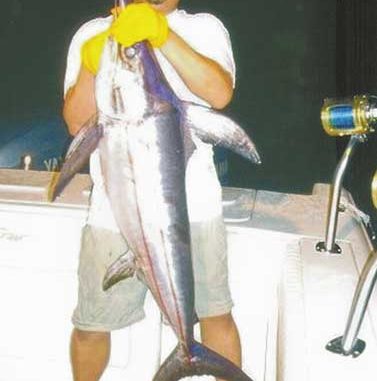
Taking on a swordfish isn’t a task for the faint-hearted, but Carolina anglers are experiencing success for the first time in that arena.
Everyone with a powerboat worries about the cost of fuel. But a dedicated angler going without a fishing fix is like a fish out of water that can’t breathe.
Perhaps the most long-suffering when it comes to fuel costs per trip are blue-water anglers. Getting to the edge of the Continental Shelf costs more than ever before. But for a couple of anglers, added fuel costs simply translate to more efficiency, such as staying out overnight to double dip a trip.
The idea of spending a night far offshore is nothing new. King mackerel anglers have fished that way for decades and commercial fishermen often live on the water after darkness falls.
But going long for swordfish is something of an experiment among recreational fishermen at the North Carolina coast. Still, it’s no surprise that two of the state’s most innovative anglers are among the first to think outside the box and challenge swordfish to night duels in 1,200 feet of water.
Capt. Brant McMullan, 32, has a lifetime of fishing experiences. He works at the family’s fishing enterprise, Ocean Isle Fishing Center.
“I’d been to Charleston and saw a boat at the commercial docks off-loading at least 100 swordfish that were going to market,” McMullan said. “Seeing all of those swordfish piqued my interest.
“I have a friend in South Florida, and he was fishing for swordfish, then we saw those swordfish at Charleston. We’re innovators, so we decided to give swordfishing a try.”
McMullan and his brother, Barrett, had quite an experience with some of the learning curve spiraling down into the negative aspects of the trip. But he said other anglers should learn from his experiences, and there was no reason for anyone who likes catching billfish not to give swordfish a shot.
“It was cloudy, so it was moonless and there were no stars in the sky,” he said. “The air temperature was in the 50s, and there was a temperature edge offshore. We had been told to go out to at least 1,200 feet of water to catch swordfish.”
McMullan headed out of the Cape Fear River at Southport. But 20 miles offshore, he almost decided to cancel the trip. He slowed down his 36-foot Contender center-console boat and did some laps as he considered heading back to the hill.
“It was December, and we left at 6 p.m.,” he said. “It was pitch black, so there was no reference point. There was no light reflection on the waves, so it was very disorienting. The wind was only 10 to 15 knots, which would have been nice by daytime standards. But I couldn’t see anything to help me gauge the wave action.”
Undaunted, McMullan talked himself into moving again. He watched the compass to get his bearings and headed out 90 miles to where he had seen a temperature edge with his in-house computer before heading out. He said the true impetus for the trip was boredom and that’s what really motivated him to keep going.
“The bluefin tuna weren’t biting at all,” he said. “We figured if there was nothing else to catch anyway, we were better off to keep running than trying to catch a bluefin tuna the following day.”
Fortunately the wind velocity never reached more than 15 knots and seas remained at 3 feet all the way to the swordfish grounds. Once the boat arrived at the temperature change, the indications were obvious.
“The temperature shot we had taken on the computer was right on target, and we could feel the air temperature change when we hit the water temperature change,” McMullan said. “The water temperature was in the 60s, but then when we hit the temperature change, the air temperature went way up into the mid 70s. It was really nice out there.”
McMullan set out three lines. The first line had no balloon, and he set the bait at 100- feet deep. The second line, with a balloon for a float and indicator, was 50 feet from the boat and the bait was set at 100 feet. The balloon from the third line was 220 feet from the boat with a bait at 200 feet.
Staggering the lines made the spread three-dimensional to increase the chances of a strike as well as preventing the lines from tangling.
McMullan said he set his lines in such a manner based upon advice from sources. He said he didn’t invent that way of fishing.
The baits were whole squid, rigged on McMullan’s standard Gulf Stream rods and reels. He was using Shimano TLD 30 reels spooled with 80-pound Power Pro braid with 80-pound mono top shots of 100 feet in length.
He tied the top-shot lines to braided line using an Albright knot. Then he used an improved clinch knot to tie a 250-pound Sampo snap swivel to the top shot. He used a crimp loop connection at the end of the leader to attach the leader to the snap swivel.
The leader was 15 feet of 200 pound monofilament. He tied a 6-inch Cylume light stick to the swivel using a No. 32 rubber band. He also used a rubber band to tie a 16-ounce bank sinker to the swivel.
The squid was rigged with a 10/0 Mustad J hook. One half of a Styrofoam trout fishing float was threaded on the leader and into the body of the squid to keep it from slipping up the line.
The balloons were blown up and knotted in place on the lines and line lengths were measured by the arm-length method. A smaller chemical light was placed inside each balloon for increased visibility.
“It was amazing how visible the balloons became with the little bitty lights inside them,” McMullan said. “They worked really well in the 3-foot seas. We changed out our baits twice during the night and replaced the lights that were fading out.”
The two swordfish strikes he experienced came on the shortest line. McMullan said he thought the fish were brought up closer to the boat by a HydroGlow light he had dropped over the side near his boat. The light was tied alongside the boat on the windward side as the Contender drifted with the wind. The lines trailed on the same side of the boat as the light.
The anglers set their spread and began drifting from the cooler side of the temperature break to the warmer side. They also had brought some steaks with them to grill for dinner, having planned to stay overnight.
“We were a little off balance because the lack of light was so disorienting,” Mcmullan said. “Nobody was at 100 percent efficiency. But eventually we cooked the steaks and went to sleep. But one of us was always on watch for ships and fish strikes.”
One swordfish struck, but didn’t hook up. The fish just made off with some line then the line went slack. The second strike was different.
“The fish basically committed suicide,” Brant said. “Barrett was on watch, so he got to catch the fish. It wasn’t a big swordfish so the fight didn’t take long because we were using heavy tackle. When it came up, it looked really weird in the light. The bill was as long as the body, and we landed it by grabbing the bill.
“It was a 42-inch swordfish and too small to keep, so we let it go after taking some pictures.
“We fished until daybreak and our plan was to stay and fish the Gulf Stream the next morning. It was a good plan, but we were all wiped out by the trip out and from spending the night. The wind was up to 15 to 20 knots and there were white caps on the waves. But gas was only $2 a gallon at the time, so it wasn’t too painful just to head back in.”
When he returned and had time to mull over his fishing decisions, Brant McMullan said he would do things differently when he went swordfishing the next time. He said he would go during a warmer month, from May through September.
He said the 50-degree air temperature some of the trip was chilly. He also said he would wait for a brighter night with some moonlight and starlight and would piggyback the trip with a trolling trip to save fuel.
He said if he could catch a swordfish and have two strikes the first time he tried, swordfish must be plentiful.
“(Next time) I’ll leave at noon, troll the break until dusk, head out another 20 miles for swordfishing at night, then troll the break the next day until noon to catch the morning bite before I head back,” he said. “It would also be nice to fish from a bigger boat. Then you could work the lines all the way down the side and have more fishing room.”
Capt. Anthony Ng of Fish-Ng Accessories caught a swordfish last August. He decided to give it a try when he was helping biologists with some research.
“Dr. Jeff Buckel with the N.C. State University Zoology Department was with me,” he said. “We were doing some research and fishing near the Same Ole, which is along the break.
“After a day of bottom fishing, we went straight offshore until we hit 1,250 feet and were 110 miles off Beaufort Inlet and 88 miles from Masonboro Inlet. I had been thinking about swordfishing for a while. I had a calm night, a full moon and somebody else crazy enough to want to go.”
Ng said bottom fishing all day then staying the night to try for a swordfish was an efficient use of time and fuel. The pair of anglers were aboard his Grady White 30-foot center console with twin 250-horsepower Yamaha motors.
“I had a light shining on the water and was fishing with Shimano Tiagra 80 reels spooled with 100-pound mono,” Ng said. “I used a 280-pound barrel swivel with crimped connections to the line and leader. The leader was 100 feet of 200-pound fluorocarbon with a crimp connection to a Mustad 10/0 hook. I taped a chemical light stick 5 feet above the leader and used a whole squid for bait. I also had some whole Boston mackerel for bait.”
Ng was trying to fish 1,200 feet of water because commercial fishermen told him it was the best depth. The surface water temperature was 85 degrees, and he drifted three times at depths of 1,100 to 1,250 feet.
“We had three strikes,” he said. “One sword swiped a mackerel; one swiped a squid; and we caught a swordfish on a squid.
“On the third drift we hooked up a 10-foot scalloped hammerhead, and we were done after that. It took an hour and a half to land the shark. It was late at night, and we had no sleep and had fished all day before that.”
Ng fished three lines with different-size sinkers. He used rubber bands to tie the sinkers to the line 50 feet above the baits.
“I had a 1-pound weight on a 300-foot line, 2 pounds on a 200-foot line and 3 pounds on a 100-foot line,” he said. “It kept the baits staggered. We caught the swordfish on the middle line.”
The swordfish was a legal size swordfish, and Ng landed it with a short grouper gaff because it was handy. Grabbing the fish by the bill also helped swing it aboard. Ng used gloves to protect his hands from the bill. When the fish first hit, Ng thought it was a shark. But when the fish jumped, he saw the long bill.
“It was a calm night with a full moon so visibility was good,” he said. “We fought the fish for 15 minutes on 12 pounds of drag.
“The fact we landed a swordfish doesn’t prove we’re experts. But if we can go out there and have three strikes the first time we gave it a try, there must be an incredible number of swordfish out there in 1,200 feet of water.”

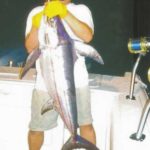
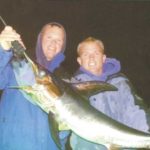

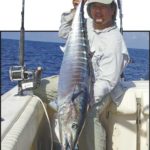
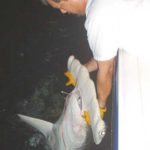
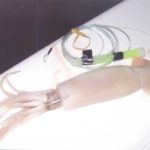



Be the first to comment